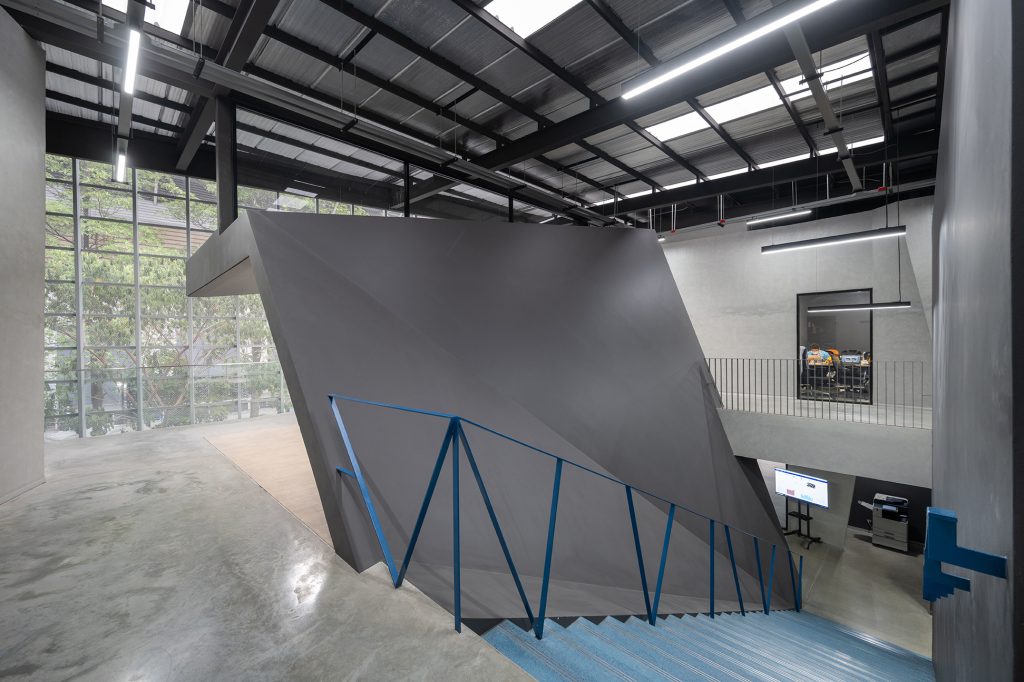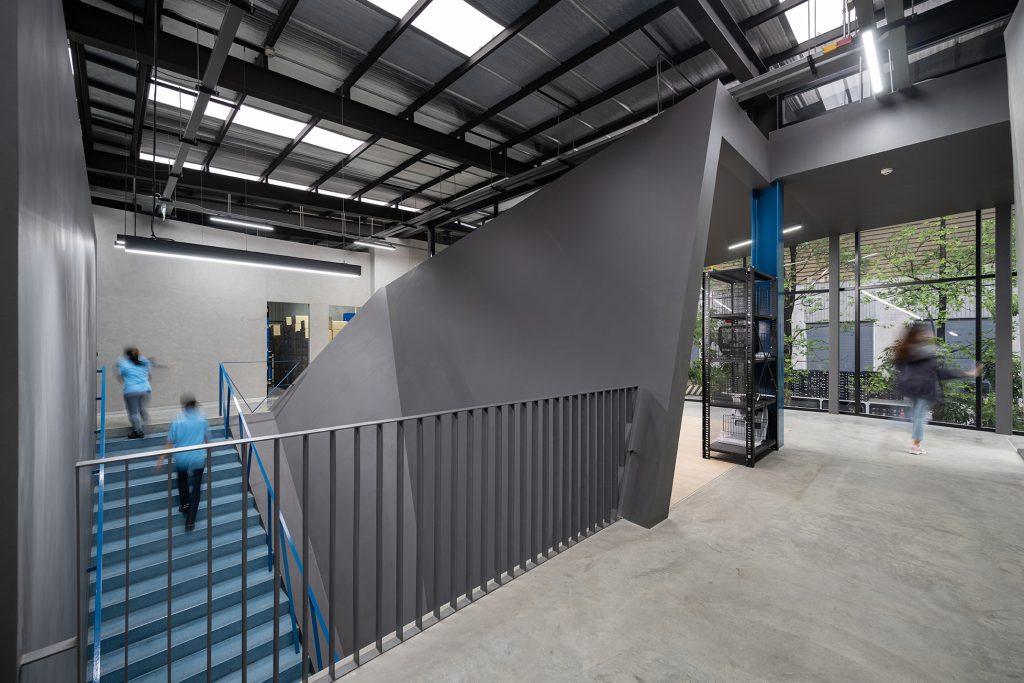In designing a new office and factory complex of BKF Aerospace – a producer of aircraft components, Office AT applied expanded metal mesh and angle steel bars to create a façade to portray the existence of invisible elements of air.
Text: Nathanich Chaidee
Photo Courtesy of Office AT and Rungkrit Charoenwat

ธุรกิจผลิตชิ้นส่วนอากาศยานของ บริษัท บีเคเอฟ แอโรสเปซ จำกัด ที่ต้องการแสดงออก ถึงภาพลักษณ์ของธุรกิจรูปแบบใหม่ซึ่งแตกยอดมาจากบางกอกพัฒนามอเตอร์ บริษัทผู้ผลิตชิ้นส่วนรถยนต์ อาคารสำนักงานที่ พื้นที่ใช้สอยต่อเนื่องกับโรงงานแห่งนี้จึงต้องบอกเล่าเรื่องราวของธุรกิจอากาศยาน สำหรับต้อนรับแขกผู้มาเยือนทั้งจากไทยและต่างประเทศ พร้อมกับสร้างคุณภาพชีวิตที่ดีให้กับพนักงาน สถาปนิกจึงต้องทำความเข้าใจกับเงื่อนไขการทำงานของโรงงานที่จะต้องดำเนินกระบวนการผลิตอยู่ตลอด และรูปแบบการก่อสร้างโรงงานที่เน้นด้านการใช้งานมากกว่างานรายละเอียด งานออกแบบจึงต้องคิดไปพร้อมกันทั้งรูปลักษณ์ของอาคารและวิธีการติดตั้งงานให้เป็นไปตามที่ต้องการ
“Façade เป็นส่วนที่แสดงออกได้ชัดเจนที่สุดว่า อิมเมจของอาคารจะเป็นอย่างไร และแตกต่างอย่างไรกับส่วนงานผลิตชิ้นส่วนรถยนต์ธรรมดา” สถาปนิกแปลความหมายของคำว่า Aero จากความรับรู้ในแบบนามธรรมมาสู่สัมผัสในแบบรูปธรรม โดยเน้นที่ Façade ที่เรียกว่าเป็นหน้าตาของอาคาร ด้วยการมองถึงอากาศที่มีความเคลื่อนไหวในแบบ Aerodynamics หรืออากาศพลศาสตร์ ซึ่งเป็นหลักการที่บอกเล่าถึงการเคลื่อนที่ของอากาศที่แปรเปลี่ยนทิศทางไปตามวัตถุที่กีดขวาง ซึ่งนับเป็นหนึ่งในหลักการออกแบบที่ใช้งานกับอากาศยานและเครื่องบินโดยตรง

“Façade นี้อยากจะเล่าถึงสิ่งที่มีอยู่ แต่เราไม่ได้มองเห็น นั่นคือเรื่องของอากาศ ความเคลื่อนไหวของอากาศ หรืออุณหภูมิ ซึ่งสิ่งเหล่านี้เป็นสิ่งที่มีอยู่ในสถาปัตยกรรมหรือสเปซอยู่แล้ว แต่เรามักจะละเลยไป อย่างเช่น พูดถึงเรื่องอุณหภูมิ ความเย็นสบายเป็นนามธรรม แต่การทำให้สิ่งเหล่านี้เป็นรูปเป็นร่างก็ไม่ได้ชัดเจนเท่าไหร่ เพราะฉะนั้น Façade นี้ก็อยากจะสะท้อนความเป็นคู่ตรงข้ามระหว่างความมั่นคง หรือกริดชัดเจนในงานสถาปัตยกรรมหรือโรงงาน กับความเคลื่อนไหวของอากาศผ่านเส้นสายออกมา”
จากจุดเริ่มต้นที่ความเคลื่อนไหว สถาปนิกเลือกใช้โปรแกรม Rhino Grasshopper เป็นผู้ช่วยในการสร้างเส้นสายของอากาศให้เกิดขึ้น ด้วยการกำหนดจุด Attractor Point จำนวน 2 จุดเป็นจุดศูนย์กลางก่อนเส้นสายจะแผ่รัศมีไปส่งผลกระทบต่อโดยรอบจุดนั้น เกิดเป็นเส้นของความเคลื่อนไหวและเอฟเฟกต์จากการแทรกสอดหรือกระจายตัวบนระนาบผนังแบบแรนดอมที่แต่ละจุดมีความเข้มอ่อนต่างกัน เหมือนกับอากาศที่เคลื่อนไหวผ่านปีกเครื่องบิน
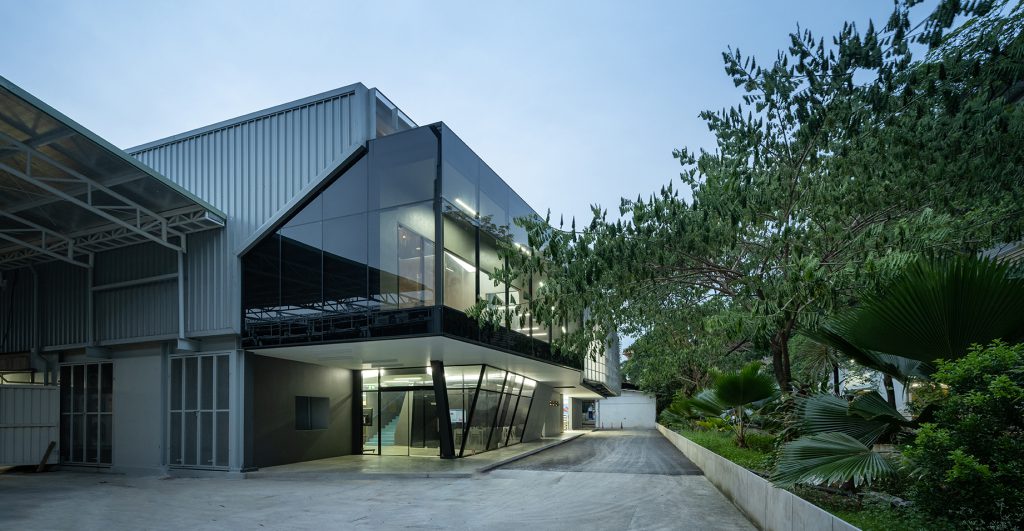
“เราอยากให้อาคารดูซับซ้อนแต่เรียบง่ายที่สุดจึงเป็นความท้าทายตั้งแต่ต้นที่ว่า ควรจะใช้ระบบหรือเทคนิคอย่างไรที่ทำให้ทำงานได้จริง” มาสู่การกำหนดชิ้นงานและแบบที่จะนำมาก่อสร้างจริง ข้อสำคัญคือจะต้องทำการเคลียร์แบบและสร้างระบบของการติดตั้งให้ทีมผู้รับเหมาเข้าใจแบบได้ง่ายที่สุด เพื่อทำงานให้ตรงแบบมากที่สุด จึงเลือกใช้วัสดุตะแกรงเหล็กฉีกและเหล็กฉากนำมาประกอบกันในแบบ Double Layer หรือซ้อนสองชั้น โดยชิ้นงานจะประกอบด้วยแผ่นตะแกรงเหล็กฉีก 7 รูปแบบ ต่างขนาดและองศา วางบิดตามแบบให้ได้เอฟเฟกต์ของความเคลื่อนไหว สลับส่วนทึบและโปร่งสอดคล้องไปกับประโยชน์ใช้สอยภายในตัวอาคาร
“ตะแกรงเหล็กฉีกประกอบกับเหล็กฉากเป็นวัสดุที่เราเลือกใช้งาน ด้วยคุณสมบัติทางสายตาที่มองจากระยะใกล้ก็รู้สึกโปร่งโล่ง มองจากระยะไกลก็ไม่ทึบมากนัก รักษาความเป็นส่วนตัวภายในอาคารได้เป็นอย่างดี รวมทั้งเส้นสายและความเคลื่อนไหวยังสร้างเอฟเฟกต์ให้ตัวอาคารได้ราบรื่นต่อเนื่องไม่ขัดตา ตามแนวคิดที่วางไว้”
การสร้างความเคลื่อนไหวส่งต่อจากกรอบอาคารเข้าไปภายในอาคารด้วยโครงสร้างเหล็กตั้งแต่จุดไฮไลต์ที่โถงทางเข้า ซึ่งเน้นให้ดูยื่น
ยาวต้อนรับผู้มาเยือนแบบโปร่งโล่ง รอบข้างใช้เสาเอียงเน้นทางเข้าไปพร้อมกับเน้นสื่อถึงความเคลื่อนไหวของตัวอาคาร เข้าไปสู่ภายในสำนักงานที่ประกอบด้วยพื้นที่ใช้สอยจำเป็นต่างๆ แต่ยังคงความลื่นไหลภายในด้วยการออกแบบที่เน้นการระบายอากาศ พร้อมกับลดการใช้เครื่องปรับอากาศภายในอาคาร ไปพร้อมกับการเชื่อมต่อพื้นที่ภายในกับบรรยากาศโดยรอบผ่านทางกรอบของอาคาร
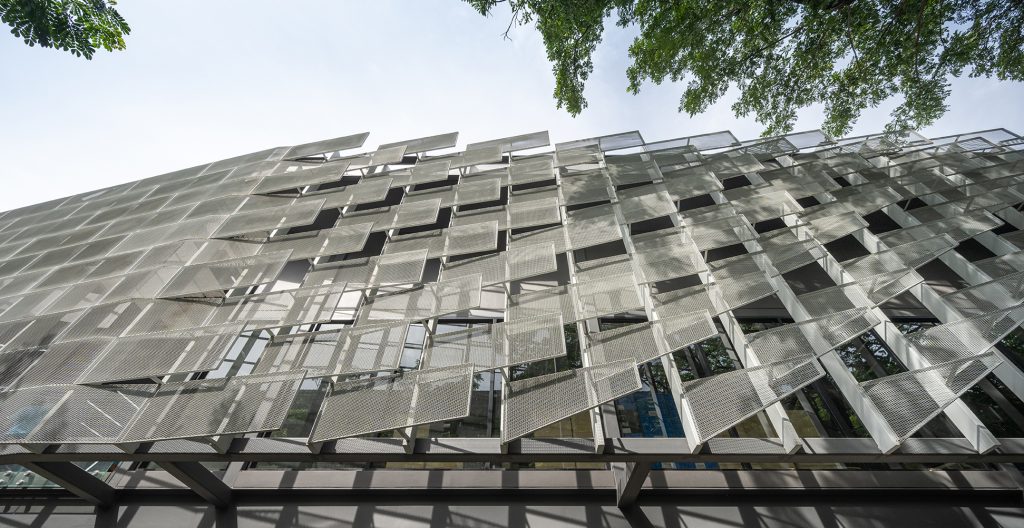
ปฏิเสธไม่ได้ว่า เทคโนโลยีเข้ามามีบทบาทต่อการออกแบบ และนวัตกรรมที่ช่วยในการออกแบบช่วยขยายขอบเขตของจินตนาการ และความเป็นไปได้ในการทำงานของสถาปนิกให้กว้างไกลต่อไปได้อีก เราจึงถามต่อถึงความคิดเห็นของทีมสถาปนิก Office AT ที่มีต่อวิวัฒนาการทำงานจากยุคเขียนมือมาสู่ยุค Computer-Generated Forms
“ช่วงปี 1997 ที่ไปเรียนต่อปริญญาโทที่มิชิแกน ตอนนั้นคอมพิวเตอร์กำลังมาแรงมาก โดยเฉพาะกับการที่มนุษย์ปล่อยคอมพิวเตอร์สร้างฟอร์มขึ้นมาด้วยตัวเอง ซึ่งเป็นยุคที่วงการกำลังคลั่งไคล้เรื่องนี้มากเพราะเป็นเรื่องใหม่ แล้วเราก็ได้เห็นงานในช่วงนั้นจาก Peter Eisenman ก็ยิ่งรู้สึกเปิดโลกขึ้นไปอีก เลยทำให้ความสนใจในด้านนี้ติดตัวตั้งแต่นั้นเป็นต้นมา แต่พอกลับมาเมืองไทยก็ขึ้นอยู่กับโปรเจกต์ว่าจะได้มีโอกาสลองใช้บ้างไหม ซึ่งก็จะแตกต่างจากการเขียนด้วยมือซึ่งก็มีเสน่ห์ในอีกแบบให้เราได้ค่อยๆ คิดตาม ลึกซึ้งไปกับงาน”
“เราว่าทั้งสองส่วนจะต้องประกอบกันให้ลงตัวพอดีเพราะก็สำคัญทั้งคู่ในยุคนี้ อย่างสเกตช์มือตอนนี้ก็อาจจะเปลี่ยนมาเป็นสเกตช์บนไอแพดแทน แต่ที่สำคัญคือโปรแกรมจะเป็นตัวช่วยให้เรายืดหยุ่นในการคิดมากขึ้น ทำให้เรารู้สึกอิสระมากยิ่งขึ้น และสร้างความเป็นไปได้ใหม่ๆ มากขึ้นในงานสถาปัตยกรรม”
หลังจากโปรแกรมในคอมพิวเตอร์แล้ว ก็เป็นหน้าที่ของการเลือกวัสดุ ซึ่งเป็นหัวใจสำคัญที่ช่วยสานต่อให้จินตนาการกลายเป็นภาพจริง ด้วยคุณสมบัติและรูปลักษณ์ที่ดัดโค้ง ประกอบขึ้นรูป ดูบางเบาแต่ยังคงความแข็งแรง และที่สำคัญคือบุคลิกที่ตอบโจทย์ทุกประการของอาคารแห่งนี้ ทำให้วัสดุเหล็กและโครงสร้างเหล็กเป็นวัสดุที่เลือกใช้ และเชื่อมต่อความใหม่ของอาคารสำนักงานแห่งนี้ กับงานหลังบ้านอย่างโรงงานได้อย่างสมบูรณ์
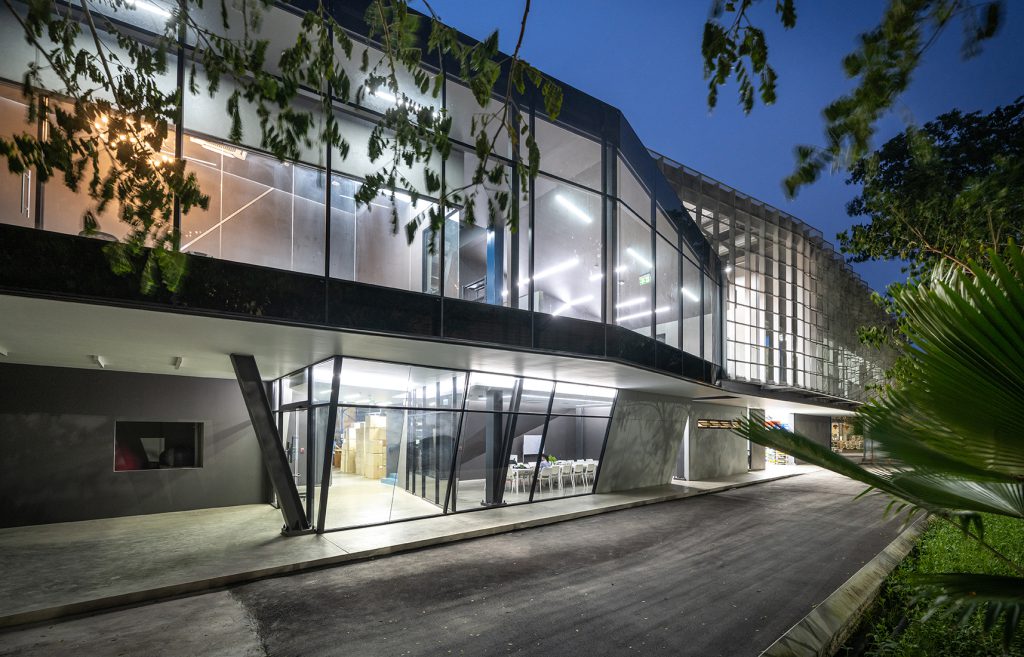
BKF Aerospace Company Limited, a producer of aircraft components, aims to display its identity as a commercial entity that is an extension of Bangkok Patana Motors, Thailand’s premier manufacturer of automobile parts. The new office building, which is physically attached to the company’s plant, is expected to tell the company’s and the aerospace industry’s stories while functionally accommodating local and foreign visitors and improving the quality of life for the company’s employees.
The architecture team, therefore, needs to comprehend the conditions of the factory and its ongoing operation, including the design that is more utility-driven rather than detail-oriented. The design has been developed with different aspects and factors in mind, from the physical appearance, to the construction and installation.
The façade is the most visible component of the building’s image and physical appeal, aiming to distinguish itself from the company’s vehicle parts manufacturing division. The architect transforms the abstract concept of ‘aero’ into something more tangible and tactile. One of the main focuses of the design is the façade, which serves as an reinforcement of the building’s and organization’s image. The design looks into aerodynamics, or the movement of air around objects, one of the laws used in the design of aircrafts and airplanes.
“This façade was created to portray the existence of invisible elements of air, as well as their movement and temperature.” These aspects, despite being essential components of architecture and space, are frequently overlooked. Temperature and thermal comfort are two examples that are naturally abstract, making it difficult to translate these elements into something tangible. What the façade seeks to represent is the polar opposite of stability or distinct grids in the factory’s design or structure and air movements depicted through visible lines.”
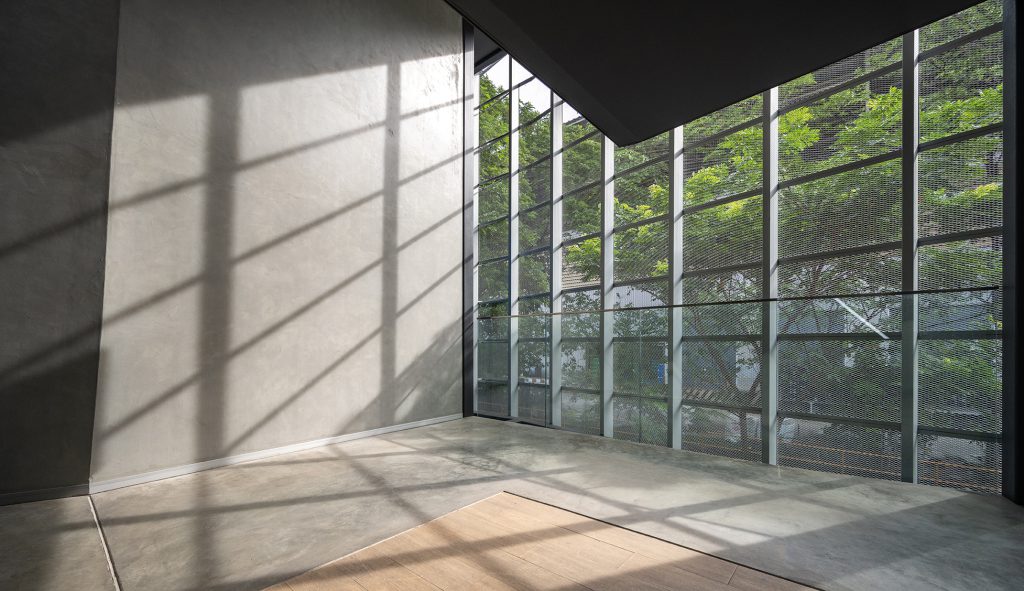
With ‘movement’ as the starting point, the design team utilizes Rhino Grasshopper to aid in the visualization of lines and streams of air. By specifying two attractor points as the central points from which the lines radiate and impact the surrounding region, lines of movements and effects were created. These lines are generated by the randomized insertion or distribution, which occurs on the plane of the wall. The points have different degrees of lightness and darkness, representing how air travels over an aircraft’s wings.
“We wanted the building to appear complex while at the same time still being relatively simple. That became the challenge from the start because we had to figure out a system or technique that would make the design work out that way.”
The subsequent development of the design and construction drawings focused on creating the drawings and installation system that would be the easiest for the contractor to work with in order for the finished work to be as accurate to the design as possible.
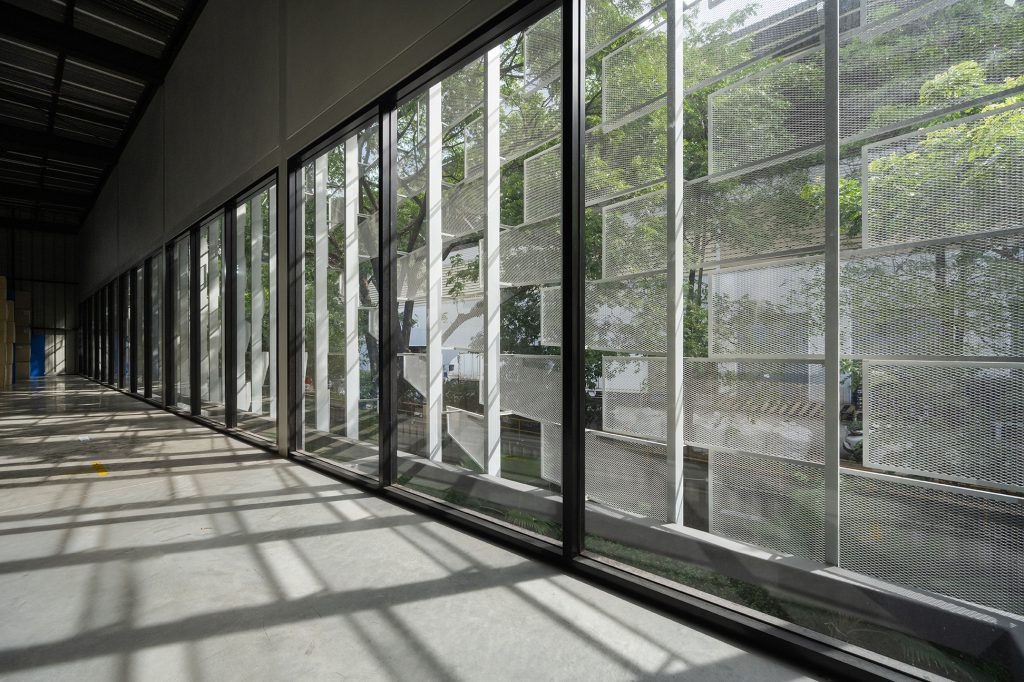
Expanded metal mesh and angle steel bars were assembled in a double layered configuration. The façade is made up of seven various sizes and angles of steel mesh. These components are installed in calculated angles and places to render the dynamic motions of air in a physical form with varied levels of density and openness that correspond with the building’s interior spatial program.
“We chose expanded steel mesh and angle steel bars as the primary materials for the façade because they provide the aesthetic attributes that make the façade appear open and airy even when viewed up close. Meanwhile, from a distance, the structure does not seem to be very dense either. The materials also enable the façade to provide privacy where it is needed whereas the lines and movements also contribute to the aesthetic flow of the building, as we intended.”
The presence of the steel structure facilitates the transfer of movements from the building’s frame into the building interior. It starts at the entrance foyer, which has been extended to welcome visitors with unobstructed openness and spaciousness. The slanted columns are utilized to emphasize the building’s entry and dynamic movement. Inside, the office section is divided into a number of functional spaces that are meant to maintain the flow of both visible and invisible elements, emphasizing ventilation efficiency while reducing the use of air conditioners. The existence of the building’s frame also connects various parts of the interior space to the surrounding setting.
It is undeniable how technology plays a significant role in design. New innovations have aided design in expanding its realm of imagination and possibilities, allowing architects to venture into new territory. We asked the architects at Office AT about their thoughts on the evolution from the time of hand-drawn design and drawings to the era of computer-generated forms.
“In 1997, when I was doing my master’s degree in Michigan, there was an early rise of computers, particularly with humans beginning to allow computers to build forms on their own.” The design industry was obsessed with this new emerging technology at the time. Then the world got to see designs that were produced during that particular time period from Peter Eisenman, and that was completely eye-opening to me, and it became the official starting point of my interest in this field of technology. However, whether or not this type of technology can be used in Thailand is entirely dependent on the project. It differs from producing things by hand, which is also appealing in its own right because it is the process that allows you to think about a design and your ideas in a contemplative and profound way.”
“I believe they should be carefully integrated because they are both vital processes in architectural design. Hand-drawn sketches are now being done on gadgets like iPad. But what matters are the programs, which can enable us be more flexible and creative with our ideas, ultimately producing new architectural possibilities.”
A thorough material selection follows the use of computer programs, because the key to turning an idea into a reality is the use of materials. With this particular project, steel materials and structures are the ideal materials for what the design hopes to achieve. They help bring the novelty of the new office building to the factory where back of house operations take place in such a perfect union with their physical properties and bendable features that appear delicate and strong at the same time.
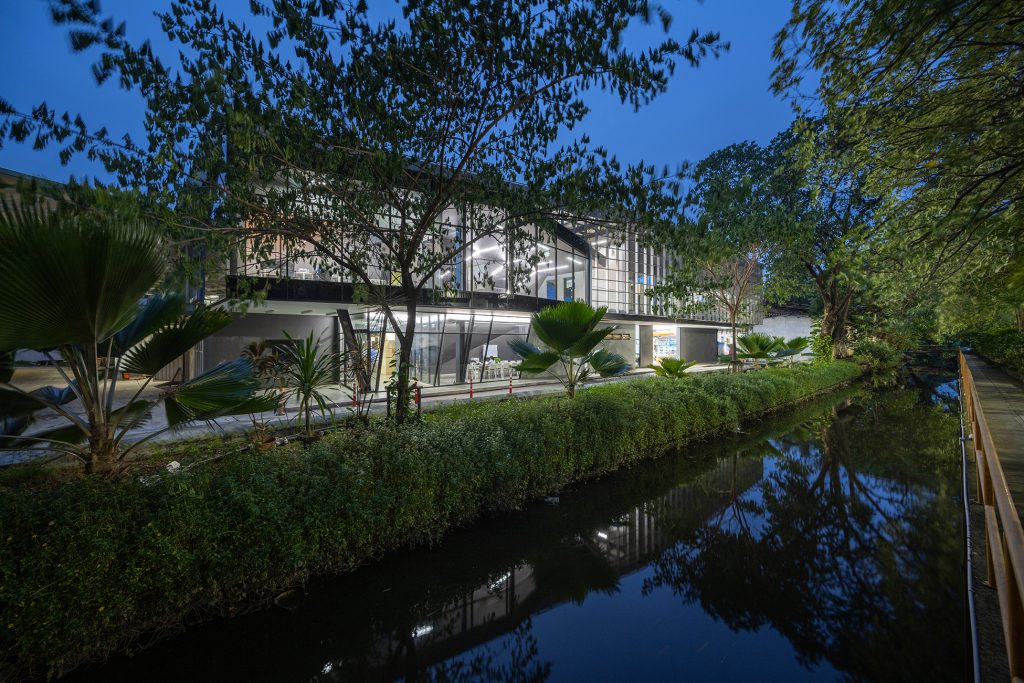
อ่านบทความคอลัมน์อื่นๆ หรือดาวน์โหลดเล่มวารสารฉบับออนไลน์ 09 Metal Attraction คลิกได้ที่นี่


